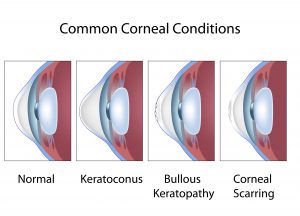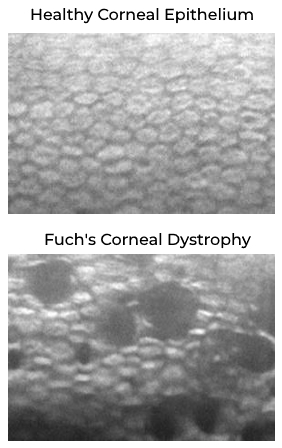
The cornea is our window to the world, the clear windshield of our eye. It is shaped like a dome and allows us to see through it while protecting the structures behind it.
It is the only tissue in the body that is clear and does not contain blood vessels. Any change to the shape, smoothness, or transparency of the cornea can cause vision problems. However, with two fellowship-trained corneal specialists in the clinic, there are plenty of options for correction.
Read about the common conditions treated at Anderson and Shapiro Eye Care below.

Keratoconus
This is a condition when the cornea thins and bulges outward, becoming cone-shaped. This irregular shape of the cornea can cause distortion of vision, glare, and discomfort. This is often treated with specialty contact lenses – called Rigid Gas Permeable (RGP) – or in severe cases corneal transplantation.
Corneal scarring
Scarring can be caused by damage to the cornea from many causes, including abrasion (scratch), laceration (cut), burns, and disease. Vision can vary from a slight blur to complete vision loss, because the clear window is damaged. Common treatments include a laser procedure, called “lamellar keratectomy”, or in severe cases a corneal transplant.

Fuchs dystrophy
This is a disorder that causes swelling in the cornea. It can lead to glare, cloudy vision, and discomfort. Fuchs usually affects both eyes and causes gradual vision loss. Mild to moderate Fuchs can be treated with eye drops, however, in severe cases, a surgery, called DSEK/DSAEK, may be necessary.
Pterygium
A pterygium is a mass of fleshy tissue that grows over the cornea. They can remain small or grow large enough to interfere with vision. These occur more often in patients that spend a lot of time outdoors. Commonly treated via surgical removal.
Astigmatism
Astigmatism, like many medical words, has Greek roots. Broken down, “stigmatos” means single point, and the preceding “a” means without. An eye with astigmatism focuses the light entering it in two (or more!) places, instead of one. This leads to blurry images and streaks or extra glow around lights.

Asymmetric curving of the cornea causes light to be focused unevenly. With uncorrected astigmatism, images may look blurry or shadowed.
Astigmatism is very common. Common means of correction include glasses, contact lenses, corneal relaxing incisions (astigmatic keratectomy), laser vision correction (LASIK), and special implant lenses.